
- Home
- Memories
- Scrapbook ▽
- Topics ▽
- People ▽
- Events
- Photos
- Site Map
- Timeline
Princesshay is of course a modern name and precinct which only came into being in 1949, when Princess Elizabeth unveiled the Princesshay Commemorative Feature. With the 1950's precinct due to be demolished, starting in February 2005, now is the time to consider the history of the area.
The whole area was within the Roman city wall, but little is known of that period - indeed, Land Securities have allowed time in the redevelopment for archaeologists to excavate the area and investigate some possible Saxon burials. Our story starts in the 13th century when a Dominican Priory, was built by a group of Black Friars at the junction of the modern Bluecoat Lane and Bedford Street, next to the post office. A hundred yards away, in 1457, St Catherine's Chapel and Almshouses were founded by Canon John Stevens to house thirteen poor men. The Dean of the Cathedral took on the upkeep of the almshouses when Stevens died, then Edward VI suppressed it, only for it to be restored to the Dean, by Elizabeth I. St Catherine's was reduced to ruins by the bombing of May 1942 - these ruins have been preserved as a memorial to that night, and will be included in the new development.
The four main buildings that would dominate the Princesshay area up to the 20th century were St John's Hospital School, Bampfylde House and Bedford House, followed by Bedford Circus.
At the Reformation in the 1530's, the priory was closed and acquired by Lord John Russell, the Duke of Bedford. In 1539 the building was converted into a private house and became known as Bedford House. It was in this house that during the siege of Exeter, the wife of Charles I, Queen Henrietta Maria gave birth on 16th June 1644 to her ninth child, called Princess Henrietta Anne.
After the Civil War, Bedford House was divided into tenements and then in 1770, the Duke of Bedford ordered that it be demolished.
In 1773, the construction of Bedford Circus was started by Robert Stribling when the first 14 houses, creating a crescent, were built. Constructing the whole circus was a long process and, not to be fully completed until 1825. There was a small, elliptical, iron fenced green inside the access road around the front of the houses. A statue of Lord Courtenay, a member of an old Devon family and MP was placed on the green the the 19th century.
In the 20th century, many of the houses became offices for insurance, banking and other businesses. On 4th May 1942, the bombing of Exeter resulted in many destroyed buildings, including Bedford Circus which was mostly burnt out.
Around about 1238, a hospital was endowed and dedicated to St John the Baptist, by the East Gate. The hospital was a religious foundation to house twelve poor people. After the Reformation of the 1530's, the hospital was shut.
It was in 1633 that the buildings were first used as a grammar school upstairs, and the English Free School downstairs. A uniform of blue caps and gowns were introduced for the boys of the English Free School, leading to the boys being nicknamed Blue Boys. A small statue of a Blue Boy was placed at the entrance to the main hall.
Heles School was formed from a spin off of the English Free School in 1840. In 1880, Bishop Temple instigated the formation of the Free Grammar School from the surviving English Free School and moved it to a new site in Victoria Park Road, Heavitree and rename it Exeter School. The main school building was demolished and replaced by a post office, and the arcade. These buildings were in the position of the Portman Building Society (2005) and across the Eastgate entrance to Princesshay and the Virgin store.
The buildings at the back of the demolished St John's Hospital School continued into the 20th century as a school. The boys entered through a small gate, let into a large gate at the end of the Arcade on the High Street. The May 1942 bombing destroyed the ancient school buildings. When Princesshay was opened in the 1950's, the Blue Boy statue that stood outside of the school was salvaged and placed on a plinth in the precinct, at a spot that marked the position of the main entrance of the school.
This house was located in Bampfylde Street, between St John's Hospital School and Bedford House. Construction, in an Elizabethan style, started in 1590 under Richard Bampfylde in a narrow street known as Raden Lane. Richard Bampfylde died in 1594 and and the house was completed by his son Sir Amias Bampfylde.
The house consisted of three stories and a cellar on a cramped site. The main hallway had a large room leading off, in which there was installed a chimney piece that reached to the ceiling. The main room on the first floor had a fine plaster ceiling along with oak panelling and a magnificent fireplace. The last Bampfylde to occupy the house was Miss Georgina Sophia Bampfylde, who died in 1814. In August 1816 the Devon County Club occupied the house for a time, followed by a 'keeper of billiard-tables'. In the early 20th century the house gradually deteriorated until 1934, when the City Council stepped in and purchased the house to open it to the public.
As the map indicates, the bombing destroyed the whole area that is within the Princesshay redevelopment. Some properties were blown apart by high explosive bombs, but the bulk of the damage was caused by fires ignited by incendiaries, or by flames blowing from one building to another. In Bedford Circus many of the houses were burnt out, rather than collapsed and could have been saved, but the decision was taken to demolish the whole area and redevelop it. St John's and Bampfylde House were total write-off's along with much of the area around about.
Thomas Sharp, a distinguished town planner was commissioned by the City Council to plan the new post-war Exeter. His book, Exeter Phoenix published in 1945 gave more detail than had been requested - he wanted the whole Princesshay area to revolve around a new shopping precinct that would be aligned to give a view of the Cathedral. This would become the country's first pedestrian only shopping street when complete.
The whole area was a modification of Sharp's plan - Princesshay was the only part to be retained, of his initial ideas, and even that was badly compromised. If Sharp's ideas had been realised, it would have been possible to walk from a proper, London Inn Square to the Cathedral Close along an extended, straight Princesshay. A shortage of money, materials and labour all contributed to the rebuilding of Exeter taking 20 or so years.
Bedford Street was realigned, and Princesshay built to intersect at right angles to give a view of the Cathedral. The Courtenay statue was moved to the top of Bedford Street, facing the High Street and the Blueboy placed in Princesshay to mark the position of St John's Hospital School. The present post-office occupies much of what was the old Bedford Circus.
Fifty years on and Princesshay is to be demolished and redeveloped, during 2005 to 2007 by Land Securities. See Princesshay Photo Essay.
The area around St Catherine's ruins will be finished first in the new development. It is planned that the old Egypt Lane will again be opened up alongside St Catherine's and it will be possible to walk around three sides of the ruins. Now that is an improvement.
A slightly realigned Princesshay will be rebuilt with the east end covered with a glass roof. In addition there will be a glassed over street crossing Princesshay and forming a new open area at the intersection. The development will turn Bedford Street into a square with access to the back of the houses that line Cathedral Close. The whole area will be fully pedestrianised and the old Post Office Street will be opened out to give a pleasant walk along the city wall.
Sources: The Story of Exeter by A M Shorto, original documents in the West Country Studies Library, Lost Exeter by Todd Gray, Exeter Phoenix by Thomas Sharp
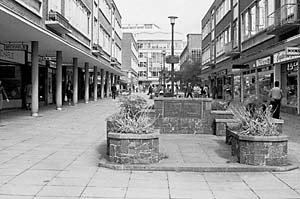 The main shopping precinct at the old Princesshay in 1979 - the Commemorative Feature is straight ahead. Photo David Cornforth
The main shopping precinct at the old Princesshay in 1979 - the Commemorative Feature is straight ahead. Photo David Cornforth
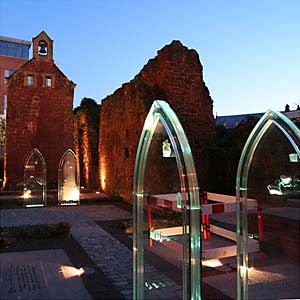 The St Catherine's ruins with the new Marking Time artwork.
The St Catherine's ruins with the new Marking Time artwork.
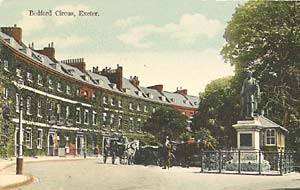 The elegant Bedford Circus at the turn of the 20th century - courtesy the Ian Jubb Collection.
The elegant Bedford Circus at the turn of the 20th century - courtesy the Ian Jubb Collection.
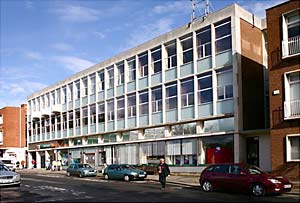 The old Post Office in Bedford Street. Photo David Cornforth
The old Post Office in Bedford Street. Photo David Cornforth
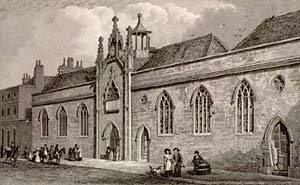 St John's Hospital School on the High Street - roughly where the Virgin Store is situated. It was demolished in 1872, leaving the main school building behind.
St John's Hospital School on the High Street - roughly where the Virgin Store is situated. It was demolished in 1872, leaving the main school building behind.
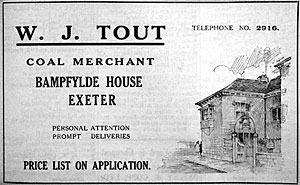 An advert for a coal merchant situated in Bampfylde House - 1920's.
An advert for a coal merchant situated in Bampfylde House - 1920's.
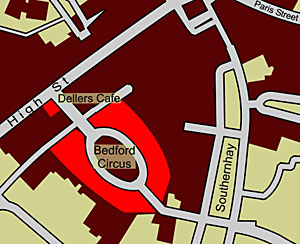 The red shows the blitzed area, while the bright red shows Dellers and Bedford Circus.Map by David Cornforth
The red shows the blitzed area, while the bright red shows Dellers and Bedford Circus.Map by David Cornforth
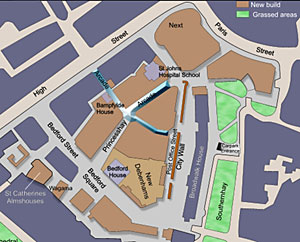 A map showing the new Princesshay, being developed by Land Securities.
A map showing the new Princesshay, being developed by Land Securities.
│ Top of Page │